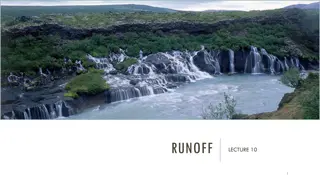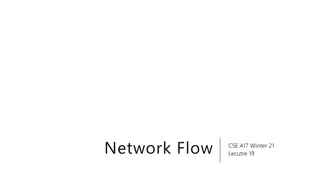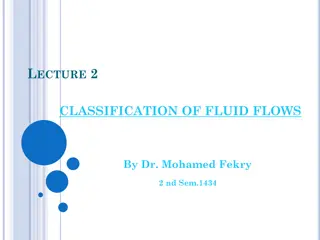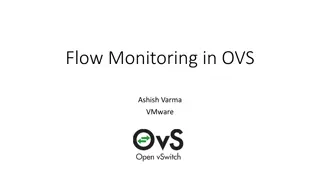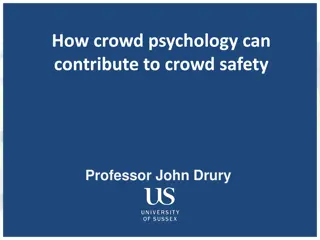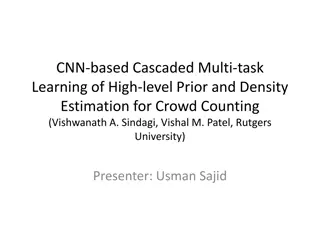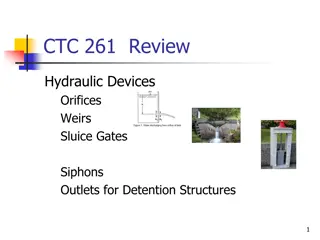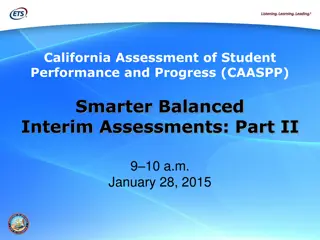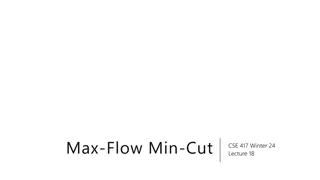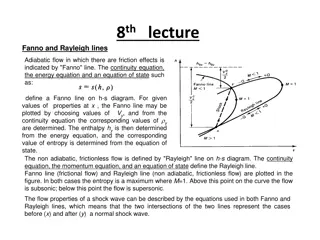Crowd Flow Model Development for Consequence Assessments
Development of a crowd flow model coupled with concentration fields for consequence assessments. The proposed model aims to predict casualty estimates by integrating pedestrian flow and hazardous atmospheric releases. Various existing models like EpiSimS, HPAC, ALOHA, and CATS are considered in the development process. The study involves microscopic and macroscopic crowd flow models, scenario-specific development in ArcGIS, and journal submission documenting the findings.
Download Presentation

Please find below an Image/Link to download the presentation.
The content on the website is provided AS IS for your information and personal use only. It may not be sold, licensed, or shared on other websites without obtaining consent from the author.If you encounter any issues during the download, it is possible that the publisher has removed the file from their server.
You are allowed to download the files provided on this website for personal or commercial use, subject to the condition that they are used lawfully. All files are the property of their respective owners.
The content on the website is provided AS IS for your information and personal use only. It may not be sold, licensed, or shared on other websites without obtaining consent from the author.
E N D
Presentation Transcript
Capstone Proposal: Development of a Crowd Flow Model Coupled with Concentration Fields for Consequence Assessments John Bambrick Advisor: Frank Hardisty 1
Outline What is Consequence Assessments Models for Coupling Proposed Model Development Case Study Journal Article 2
WHAT IS CONSEQUENCE ASSESSMENTS (CA)? 3
Analysis of Risk/Threat from Hazardous Atmospheric Releases 2002 Accidental Release of Chlorine Gas from a Railcar in Festus, MO. http://www.aristatek.com/Newsletter/OCT07/OCT07ts.aspx 4
CA Models EpiSimS HPAC ALOHA ALOHA CATS CATS QUIC QUIC HPAC Is commonly used by civil government and military Couples hazard plume with static population dataset for casualty estimate Has potential for over prediction of casualties 6
Crowd Flow Models (2 Categories) Microscopic Simulates individuals Discrete position Computationally heavy Applied within EpiSimS Macroscopic Models density flow 1D and 2D cellular Computationally light Applied within ??? Simulated Individuals Moving Around an Obstacle http://www.cs.virginia.edu/~gfx/pubs/group_behaviors_2/jar_herd.pdf Cellar Flow of Density http://scholar.lib.vt.edu/theses/available/etd-12152006-143454/unrestricted/NewCM.pdf 7
Proposal Develop a prototype macroscopic crowd flow model coupled with CA outputs to predict casualty estimates Develop a 2D pedestrian flow model Develop for specific scenario Build in ArcGIS 9.3 with VBA Couple HPAC outputs with 2D flow model Document in journal submission 9
Concepts Behind Model http://www.timtim.com/drawing/vie w/drawing_id/398 Running with the Bulls http://www.flickr.com/photos/mcmahon/4788415049/ http://www.theipinionsjournal.com/index.php/2006/07/its-official-second-hand- smoke-kills/ 10
Key Components Concentration Fields From HPAC Environment Crowd Obstacles Terrain Egresses Crowd Flow Model 11
Key Functions Dosage calculation Dosage = Concentration Time Step Crowd flow model Primary flow driver Recognize hazard Determine directional flow based on hazard Unique for differing hazard types Secondary flow drivers Model crowd density Find path of least resistance Find egress for escape from hazardous environment Selection between primary and secondary flow factors 12
Quasi-Macroscopic True Macroscopic Quasi-Macroscopic T1 T2 T1 T2 =9 =3 =5 =6 =5 =5 =2 =7 =4 =4 =6 =4 =3 =2 =3 =3 =2 =2 Moved out Moved in Stayed in Concentrations Model density flow Know density but not who went where No way to know who got what exposure Model individual in flow Track who went where Track exposure of each individual 13
Primary vs. Secondary Flow Direction Hazard T1 Fast Flow Rate Primary Slow Split Primary and Secondary Primary Only Secondary Only Secondary Secondary T2 Primary Primary 14
Data Population shapefile Point geometry Attributes Characteristics Status Variables Concentration fields & aspect Source: HPAC Point geometry interpolated to raster Environmental rasters Density & aspect, slope Distance from obstacles & aspect of slope Terrain 15
Data Flow Input User: Study Area Definitions Output Crowd Flow Model Population Data Location, tn-1, tn Integrated Exposure Environment Population Density People Rate Flow Direction Secondary Flow: Path of Least Resistance Primary Flow: Hazard Induced Flow Direction Urgency: Hazard Induced Concentration Field / Flow Driver HPAC 16
Variable Sources for Primary and Secondary Flow (Conceptual) Primary direction Aspect (downward direction) of concentration Secondary direction Aspect of density (weighted by slope) Perpendicular to aspect of the slope of distance to the obstacle (weighted by inverse of distance) Rate Urgency Function of concentration above detectable levels but limited to individual s max speed Resistance Function of density Friction factor classified by terrain 17
Time Step Sequence Tn-1 Tn Slope Slope FlowDirection Calculation Flow Vector Pop X,Y tn-1 Population Density Kernel Density Aspect Aspect Pop X,Y tn Time Step Intake Rate Calculation Output tn-1 Conc. Field Aspect IDW Aspect HPAC Conc. Field IDW Output tn Constants Distance Aspect Point Data Obstacles Aspect Distance Raster Geoprocess Friction Factor Terrain Reclassify Extract from Raster at Point Internal Calculation 18
Development Priorities Calculation of individual s intakes from concentration fields at Tn location (Required) Create individual s primary flow vector at Tn and new location (Required) Create secondary flow direction based on density and selection algorithm (Required) Create secondary flow direction based on obstacle avoidance and selection algorithm (Optional - probable) Apply terrain based friction factors to flow rate (Optional possible) Create secondary flow direction toward egresses and selection algorithm (Optional - doubtful) 19
CASE STUDY 20
Case Study Accident results in Cl2 released near pedestrian mall Cl2 Visible and odorous Irritation and harmful effects Cl2 acts as primary flow driver (crowd responds) Flow from high to low concentrations Urgency determined by concentration level 21
Expected Results Dosage developing over time Casualty estimates provided Results comparatively different from a static population Each run of model unique Exploration of scale adaptability 22
Article Submission Purpose: To propose and promote the use of dynamic population flow models in consequence assessments Contents Present concepts of model Demonstrate the working conceptual model Suggest uses Identify areas for future development Candidate journals Risk Management Journal of Homeland Security Journal of Homeland Security and Emergency Management 24
QUESTIONS? 25




